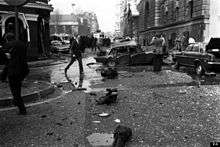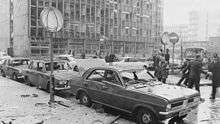1973 Old Bailey bombing
| 1973 Old Bailey Bombing | |
|---|---|
| Part of the Troubles | |
|
Entrance door to the Old Bailey | |
| Location | London, United Kingdom |
| Date |
8 March 1973 14:49 (UTC) |
| Target | Old Bailey Courthouse |
Attack type | Car bomb |
| Deaths | 1 British civilian (heart attack) |
Non-fatal injuries | 200 |
| Perpetrator | Provisional IRA Belfast Brigade |
| Assailants | William Armstrong, Martin Brady, Hugh Feeney, Paul Holmes, Gerry Kelly, William McLarnon, Roisin McNearney, Dolours Price, Marian Price, Robert Walsh |
| Convicted | all but McNearney (acquitted for providing information) |
| Verdict | life in prison (later reduced to 20 years) |
The 1973 Old Bailey bombing was a car bomb attack which took place outside the Old Bailey Courthouse on 8 March 1973. The attack was carried out by a 10-person ASU from the Provisional IRA Belfast Brigade. One British civilian died of a heart attack attributed to the bombing. A second bomb went off outside the Ministry of Agriculture, and two additional bombs were found and defused. Nine people from Belfast were convicted six months later for the bombing, and one acquitted for providing information to the police.[1]
Background
The Troubles had been raging for four years in Northern Ireland and to a lesser extent the Republic of Ireland since the Battle of the Bogside in Derry in August 1969 which brought British troops to Ireland for the first time since 1921. Rioting, gun battles, sniper attacks, bombings and punishment beatings became part of everyday life in many places. These events and others helped to heighten sectarianism and boosted recruitment into Irish republican and Ulster loyalist paramilitary groups and the security forces. Great Britain had been relatively untouched up until the beginning of 1973, but the IRA Army Council had drawn up plans for a bombing campaign to take place in England some time early in 1973.
It has been alleged that Gerry Adams was the overall Commander of the IRA's Belfast Brigade at the time and was tasked with selecting the Volunteers who would constitute the active service unit for the England bombing operation, which was scheduled to take place on 8 March 1973, the same day that an independence referendum – boycotted by Nationalists and Roman Catholics [2] – was being held in Belfast. The team included 19-year-old Gerry Kelly, 24-year-old Robert Walsh (an expert bomb maker from Belfast), Hugh Feeney (a Belfast-born IRA volunteer), and two sisters, Marian, 19, and Dolours Price, 22, from Belfast, along with five other lesser known volunteers from Belfast: Martin Brady, 22, William Armstrong, 29, Paul Holmes, 19, William McLarnon, 19, and Roisin McNearney, 18.[3]
Bombing



Several days before the bombing, the leaders of the Provisional Irish Republican Army active service unit (ASU), which included sisters Marian and Dolours Price, went to London and picked out four targets: the Old Bailey, the Ministry of Agriculture, an army recruitment office near Whitehall, and New Scotland Yard. They then reported back to their Officer Commanding in Belfast, and the IRA Army Council gave the go ahead. The bombs were made in Ireland and transported to London via ferry, according to Marian Price.
The Royal Ulster Constabulary warned the British that the ASU was travelling to England, but were unable to provide specifics as to the target.[4]
The drivers and the volunteers who were to prime the bombs woke up at 6:00 a.m. and drove the car bombs to their various targets. It was planned that by the time the bombs went off at around 15:00, the active service unit would be back in Ireland. The bomb at New Scotland Yard was found at 8:30 by a policeman who noticed a discrepancy in the licence plate.[2][1] The bomb team started lifting out 5-pound bags of explosives and separated them, so that if the bomb did go off, the force of the explosion would be greatly reduced. The bomb squad eventually found the detonating cord leads, which ran under the front passenger seat of the car; Peter Gurney, a senior member of New Scotland Yard, cut the detonator cord leads, defusing the bomb.
However, at the Old Bailey the bomb exploded, injuring many and causing extensive damage. Scotland Yard stated it had warned the City of London police at 14:01 to search near the Old Bailey for a green Ford Cortina; the car was not located until 14:35 and exploded at 14:49 while police were evacuating the area. [1] A shard of glass from the explosion is preserved as a reminder, embedded in the wall at the top of the main stairs. Several more people were injured by the car bomb near the Ministry of Agriculture, which brought the total number injured to over 200. A British man, 60-year-old Frederick Milton, died of a heart attack.[5] Dolours Price wrote in her memoir: "There were warnings phoned in but people had stood about, curious to see... If people ignored the warnings and stood around gawking, they were stupid. The numbers of injured came about through curiosity and stupidity."[3]
The ASU was caught trying to leave the country at Heathrow Airport prior to the explosions, as the police had been forewarned about the bombings and were checking all passengers to Belfast and Dublin. All 10 gave false names that did not match their documents.[2][1]
Court and sentence
The IRA Volunteers had to be tried at Winchester Crown court as the Old Bailey was wrecked by the car bomb there. The trial took 10 weeks and was set amid extremely strict security. William McLarnon pleaded guilty to all charges on the first day of the trial. On 14 November 1973, a jury convicted six men and two women of the bombings. The jury acquitted Roisin McNearney in exchange for information, and she was given a new identity. As her verdict was handed down, the other defendants began to hum the "Dead March from Saul", and one threw a coin at her, shouting "Take your blood money with you" as she left the dock in tears.[6]
At the court, the judge sentenced the eight to life imprisonment for the bombings and 20 years for conspiracy, while McLarnon was sentenced to 15 years.[2] As the eight were led to the cells below the court, several gave raised fist salutes to relatives and friends in the public gallery, who shouted "Keep your chins up" and "All the best". The Price sisters immediately went on hunger strike, soon followed by Feeney and Kelly, for the right not to do prison work and to be repatriated to a jail in Ireland. The bombers on hunger strike were eventually moved to jails in Ireland as part of the 1975 IRA truce agreed with the British. In 1983, Kelly escaped from Maze Prison, but was recaptured three years later.[6]
See also
- Kings Arms, Woolwich
- Guildford pub bombings
- London Hilton bombing
- M62 coach bombing
- Caterham Arms Pub Bombing
References
- 1 2 3 4 "Ten held after Provo bombs blast London". The Guardian. 9 March 1973. Retrieved 27 September 2016.
- 1 2 3 4 Eder, Richard (16 November 1973). "8 Get Life Terms in London Blasts". The New York Times. Retrieved 27 September 2016.
- 1 2 Sawyer, Patrick; Graham, Bob (23 September 2012). "IRA bomber says Adams ordered terror attacks on London targets". The Irish Independent. Retrieved 27 September 2016.
- ↑ Wilson, Ray; Adams, Ian (2015). Special Branch: A History: 1883-2006. Biteback Publishing. p. 234. ISBN 9781849549639. Retrieved 27 September 2016.
- ↑ "Old Bailey bomber arrested over murder of two soldiers". The Daily Telegraph. 17 November 2009. Retrieved 27 September 2016.
- 1 2 "BBC ON THIS DAY: IRA gang convicted of London bombings". BBC News. 14 November 1973. Retrieved 27 September 2016.